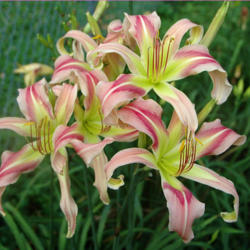
The main difference between container and garden plantings is that you'll need to water containers more often--small containers may need watering twice a day during hot, sunny weather. And because the roots are confined and can't go searching for nutrients, you'll need to provide regular feedings. A weekly application of a balanced liquid fertilizer, such as a seaweed/fish emulsion mix, should suffice.
And you'll need to keep an eye out for insect and disease problems. While container-grown plants are sometimes less vulnerable to pest attack, because they receive extra attention and pampering, you'll want to examine the foliage, flowers, and fruit regularly. Many insects can be controlled with an occasional spray of insecticidal soap. Some insects, such as aphids, can be kept in check by simply hosing them off the plants every few days.
Matching Containers to PlantsYou might choose the plants first, then look for containers that will suit them, or you can start with the container and choose plants to complement the shape and color. You can create a lively mix of brightly-colored pots in a variety of shapes, sizes, and materials, or stick with a simple theme and let the flowers grab all the attention.
Annual flowers, with their compact root systems and short life span, can be grown in almost any container, providing it has adequate drainage. They're the best choice for window boxes, hanging planters, and wire and moss baskets. Annuals are also appropriate for planters that might be damaged by winter weather--at the end of the season, you can remove what's left of the plants, clean the containers, and store them in a safe place for the winter.
Perennials do best in relatively large containers. Wood and weatherproof plastic planters are good choices. In regions with mild winters, you can use clay pots; however, in cold regions these are likely to crack as the soil in them freezes and expands.
PlantingIf you've purchased transplants or started your own seeds indoors, harden off the plants before planting them into their permanent container. It's much easier to move small flats around as you gradually expose the plants to outdoor conditions. If you're planting seeds, follow the guidelines on the seed packet to determine planting dates. You can move the planting date up by a week or two if your can move your containers to a sheltered spot if a cold snap threatens.
For perennials, it's a good idea to follow the recommended spacing. However, annuals can be packed in a little more tightly than you would in the open garden, to create a nice, full look.
What says summer like an overflowing basket of pink petunias, or a windowbox filled with bright red geraniums? Most gardeners begin their foray into container gardening with baskets and boxes of colorful annual flowers. And with good reason: Annual flowers are readily available, reasonably priced, and easy to care for, and provide the most "bang for the buck" of all container plants.
Annuals or Perennials?
What's the difference between the two? Botanically speaking, annual flowers complete their life cycle in one growing season. They sprout in the spring, grow foliage, then produce flowers and finally seeds. Once the plants have produced mature seeds, their mission is accomplished and they die.
Perennials also produce flowers and seeds, but don't die at the end of the growing season. Their above-ground parts die back, but their roots overwinter, and the plants resprout in the spring. Some perennials are relatively short-lived; lupines and primroses, for example, may live for only 2 to 5 years, though the seed they drop often produces new plants. Daylilies and coreopsis, on the other hand, can live for decades (though they'll need dividing every few years to remain vigorous).
Which should you plant? Let's look at some general characteristics of annuals and perennials.
Annuals
Perennials
So, should you plant annuals or perennials? The answer depends on what you hope to get from your planting. If you want consistent color all season long, annuals are the way to go. If you enjoy watching the seasons unfold as various plants enter their peak bloom period, and you're willing to do some annual maintenance chores, then a carefully selected mix of perennials will fit the bill.
There are literally hundreds of different annuals and perennials from which to choose. Check out our Plants Database for almost endless options.